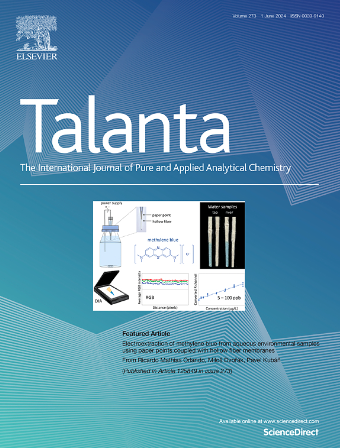利用CRISPR- cas12a和结扎滚圈扩增技术实现多CRISPR区驱动的DNA超灵敏检测
IF 5.6
1区 化学
Q1 CHEMISTRY, ANALYTICAL
引用次数: 0
摘要
高灵敏度检测特定DNA(包括单核苷酸变异(snv))的能力对于推进基因研究、诊断和个性化医疗至关重要。本研究提出了一种结合结扎滚环扩增(L-RCA)和CRISPR-Cas12a的超灵敏DNA检测新方法。虽然L-RCA系统已广泛用于核酸检测,但常规L-RCA的灵敏度一般在100pm左右。在这里,我们证明了RCA-Cas12a系统的敏感性可以通过将多个CRISPR靶区纳入挂锁探针而显着增强。该方法具有显著的灵敏度,检测浓度低至1am(每次反应6拷贝)的DNA,并且能够识别等位基因分数低至1%的单核苷酸变异(snv)。与当前许多复杂的RCA-Cas12a策略不同,这种方法简单,不需要先进的标记或仪器,使其成为各种应用中超灵敏DNA检测的有前途的工具。本文章由计算机程序翻译,如有差异,请以英文原文为准。
Multiple CRISPR zones-driven ultrasensitive detection of DNA via CRISPR-Cas12a and ligation-rolling circle amplification
The ability to detect specific DNA, including single nucleotide variants (SNVs), with high sensitivity is essential for advancing genetic research, diagnostics, and personalized medicine. This study presents a novel method for ultrasensitive DNA detection, combining ligation-rolling circle amplification (L-RCA) with CRISPR-Cas12a. While L-RCA systems have been widely used for nucleic acid detection, the sensitivity of conventional L-RCA generally reaches approximately 100 pM. Here, we demonstrate that the sensitivity of RCA-Cas12a systems can be markedly enhanced by incorporating multiple CRISPR target regions into the padlock probe. This method achieves remarkable sensitivity, detecting DNA at concentrations as low as 1 aM (6 copies per reaction), and is capable of identifying single nucleotide variants (SNVs) with allele fractions as low as 1 %. Unlike many current complex RCA-Cas12a strategies, this approach is simple and does not require advanced labeling or instrumentation, making it a promising tool for ultrasensitive DNA detection in various applications.
求助全文
通过发布文献求助,成功后即可免费获取论文全文。
去求助
来源期刊

Talanta
化学-分析化学
CiteScore
12.30
自引率
4.90%
发文量
861
审稿时长
29 days
期刊介绍:
Talanta provides a forum for the publication of original research papers, short communications, and critical reviews in all branches of pure and applied analytical chemistry. Papers are evaluated based on established guidelines, including the fundamental nature of the study, scientific novelty, substantial improvement or advantage over existing technology or methods, and demonstrated analytical applicability. Original research papers on fundamental studies, and on novel sensor and instrumentation developments, are encouraged. Novel or improved applications in areas such as clinical and biological chemistry, environmental analysis, geochemistry, materials science and engineering, and analytical platforms for omics development are welcome.
Analytical performance of methods should be determined, including interference and matrix effects, and methods should be validated by comparison with a standard method, or analysis of a certified reference material. Simple spiking recoveries may not be sufficient. The developed method should especially comprise information on selectivity, sensitivity, detection limits, accuracy, and reliability. However, applying official validation or robustness studies to a routine method or technique does not necessarily constitute novelty. Proper statistical treatment of the data should be provided. Relevant literature should be cited, including related publications by the authors, and authors should discuss how their proposed methodology compares with previously reported methods.
 求助内容:
求助内容: 应助结果提醒方式:
应助结果提醒方式:


